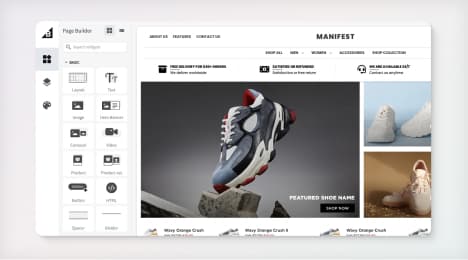
Watch Our Product Tour
See how BigCommerce helps you build and manage your online store with ease.
- Ecommerce Insights

6 Key Steps to Launch Your Online Store
Explore our Launch Foundations series to get your BigCommerce store up and running quickly.
BigCommerce helps growing businesses, enterprise brands, and everything in-between sell more online.
What is Visual Commerce?
Visual commerce the concept of leveraging compelling visual content and augmented reality to enhance customer experience. Online brands can particularly benefit from this as it familiarizes people with products.
Visual Commerce Tips
Ecommerce sales have been steadily increasing for more than a decade.
The COVID-19 pandemic boosted the popularity of ecommerce, especially during the spring 2020 lockdown that caused brick and mortar shops to close. While stores are now open, customers may still be hesitant to shop in-store, especially when they have a digital alternative.
However, this means your customers aren't physically spending as much time with your products. They’re unable to hold the object, observe its physical qualities, or discuss the product with a store associate. Instead, they must rely on the information your brand provides about products online to make their purchasing decision.
If you don't present your merchandise and brand effectively, your customers' unfamiliarity with the products may cause them to abandon their shopping carts.
Visual commerce directly answers consumer anxieties while shopping online. If implemented properly, it elevates the visual quality of your brand as a method of generating sales.
Visual commerce as a concept isn't a solution in itself. Ecommerce companies must closely examine their value add and offerings to develop compelling visual commerce content. Companies can follow the steps listed in this article to get started.
1. Use Visuals to Differentiate Your Brand.
Visual commerce is about more than creating a collage of interesting images on your website. The visual elements must be employed strategically to define your brand by differentiating it from competitors in the market.
First, it’s important to note that visual commerce includes more than just still images. In fact, effective visual commerce often includes a variety of media, such as video, gifs, and VR elements. Regardless of the medium, all of your visuals should meet the following criteria:
High-resolution imagery
Crisp visuals without blurriness
Visual content that reflects the brand
Cultivating high-resolution, clean images can be achieved relatively easily. However, it takes a bit more forethought to capture your brand through visual media. Consider your audience and target market. What do they want to get out of your products? How can you encourage them to involve themselves in your brand community?
Companies like Under Armour, an athletic apparel retailer, embrace their audience’s desire for improved athletic performance in their visual commerce materials.
Source: Under Armour
On the company home page, shoppers will find a video feed of action-packed, emotional athletic footage looping behind the message “Under Armour makes you better.” The videos strengthen the impact of the written message while engaging viewers with dynamic, moving content.
Furthermore, the website employs visual commerce to explain innovative initiatives like 3D product samples. In this case, the visual aids shoppers in clearly understanding an otherwise complex, behind-the-scenes process. This imagery allowed customers to understand how Under Armour is working to become a more sustainable brand.
Source: Under Armour
Here, customers are afforded greater insight into the brand than they would have received in-store. This allows Under Armour to make themselves more accessible to environmentally-conscious buyers.
Along with many other companies that have strategically cultivated a distinct brand, Under Armour has leveraged visual commerce to further differentiate its voice in a saturated retail market.
2. Showcase User-Generated Content
User-generated content familiarizes customers with how others engage and interact with your brand. Their experiences can inspire new customers to become more comfortable with making online purchases from your company.
In that way, presenting user-generated content on your website and social media accounts is effective without requiring additional marketing resources. Your team can simply select and feature content that already exists.
In some cases, customers prefer user-generated content to branded visuals anyway.
One of the most compelling forms of user-generated content is on-site online reviews from past customers about their past purchases. The reviews give customers the opportunity to provide feedback while giving insight to future clients on the buying experience.
According to experts, 91% of consumers read online reviews in order to get a feel for a brand before making a purchase. On top of that, 84% of people trust reviews just as much as they would a word-of-mouth recommendation.
Women’s clothing brand, Selfie Leslie, leverages user-generated reviews and visuals on their website to encourage hesitant consumers to become more familiar with the brand and its products.
Source: Selfie Leslie
In addition to a star rating, the site allows past customers to comment on the quality of their purchase and include a picture of what their clothes look like while being worn.
Fashion brands and companies with highly-visual products should consider introducing user-generated images to their on-site reviews. These elements help customers visualize the shape and fit of their clothing.
Additionally, the product being reviewed is clearly tagged within the comment. This helps customers easily find and verify the quality of the products they’re considering for purchase.
Client reviews elevate the credibility of your brand, allowing hesitant buyers to see your services from a peer’s perspective. This level of engagement promotes a closeness to your brand that functionally replaces the need for a brick and mortar experience.
3. Make Content Immersive
Effective visual commerce techniques should leave your customers feeling completely immersed in your brand and products.
This can appear challenging without a brick and mortar space, but businesses can leverage innovative technologies like AI, AR, or VR to enable customers to visualize themselves enjoying your products before purchase.
One popular method of immersive visual commerce is using a shoppability tool that allows a user to click on a product within an image for purchase. After being engaged by a product in a photo, shoppers can easily click through to a product page.
This makes the browsing process more intuitive and akin to an in-store situation. The more natural process will save people time scrolling through product listing pages, and create a more compelling experience.
Some brand sites replicate in-store occurrences even further, allowing customers to virtually try on products using their phone cameras and digitized products.
Engagement ring retailers and jewelry stores like Brilliant Earth have developed ways for customers to try on customized rings based on shape, carat size, and precious metal.
Source: Brilliant Earth
Virtual try-on opportunities take some of the pressure off of customers considering a big purchase. For instance, not many people would feel comfortable buying a diamond ring without trying it on first. Brilliant Earth anticipates and responds to this problem within their ecommerce experience, to make users confident in their purchases.
Immersive visual commerce gives customers the opportunity to closely familiarize themselves with your offerings without having to step into a store, making the purchasing process more convenient without sacrificing consumer confidence.
Visual Commerce Can Boost Ecommerce Performance
Creating compelling ecommerce content that rivals the quality of an in-store experience can seem like an overwhelming challenge. However, visual commerce serves as an opportunity to distinguish your brand in competitive markets.
By strategically developing innovative visual content that aligns with your established brand and immerses customers in products, you help hesitant buyers make purchasing decisions. Showcasing user-generated images and reviews further elevate your credibility, making your products seem more familiar to potential customers.
BigCommerce helps growing businesses, enterprise brands, and everything in-between sell more online.
Start growing your ecommerce business even faster.
High-volume or established business? Request a demo